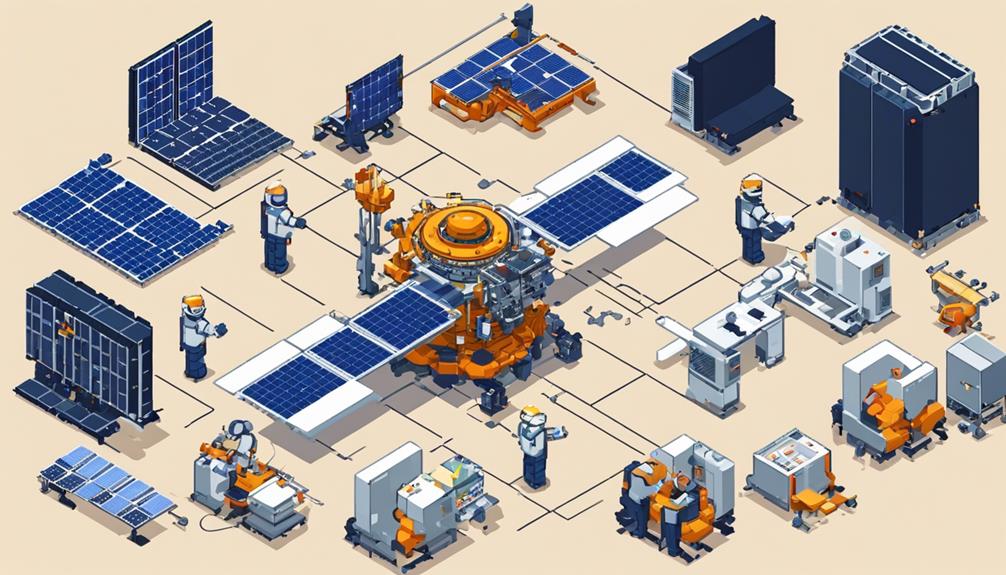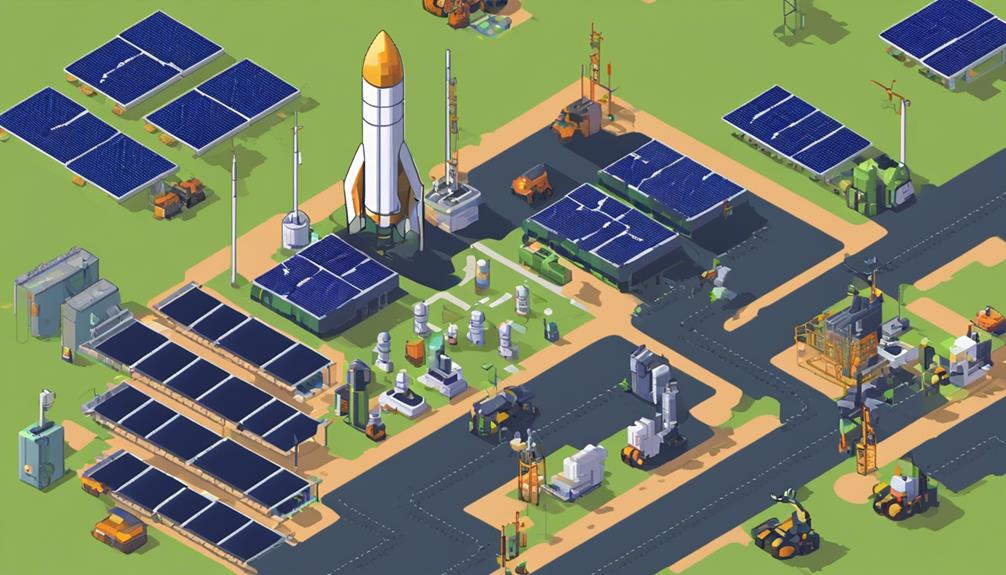In the realm of satellite launch operations, the pursuit of green practices has garnered significant attention in recent years. By integrating sustainable methodologies, the aerospace industry is aiming to curtail its ecological footprint and embrace environmentally conscious approaches. From exploring alternative propellants to designing satellites with recyclable materials, the quest for greener satellite launches presents a myriad of technical challenges and innovative solutions. As advancements in green propulsion technologies continue to evolve, the potential for revolutionizing space exploration while safeguarding our planet's ecosystem looms on the horizon.
Key Takeaways
- Propane and Bio-propane fuel choices significantly reduce carbon emissions in satellite launches.
- Utilizing sustainable materials like advanced composites and recycled elements minimizes environmental impact.
- Recycling and reusing satellite components post-launch promotes sustainability and cost-efficiency.
- Adopting green propulsion technologies, such as electric propulsion systems, aligns with sustainability goals.
Eco-Friendly Fuels for Satellite Launches

The utilization of propane as a clean-burning fuel in satellite launches has gained traction within the space industry due to its environmentally friendly properties. Propane, particularly when sourced as bio-propane, has shown the capability to significantly reduce carbon emissions in satellite launch operations. Studies have indicated that bio-propane can lead to a remarkable reduction of up to 96% in CO2 emissions, especially in microlaunchers. This makes it a highly attractive eco-friendly fuel choice for companies looking to minimize their environmental impact during satellite launches.
Transitioning to propane fuel marks a substantial shift towards more sustainable practices in the space industry. By opting for propane over traditional rocket fuels, companies are actively contributing to the reduction of carbon emissions and aligning with global efforts to mitigate climate change. The environmental benefits of using propane in satellite launches extend beyond just the reduced emissions; propane also offers a sustainable alternative that supports the industry's goals of achieving greater operational sustainability.
The integration of propane as a fuel for satellite launches represents a pivotal step in the industry's journey towards embracing eco-friendly practices. As the space sector continues to prioritize sustainability, the adoption of propane stands out as a key strategy in minimizing the environmental footprint of satellite launch operations.
Sustainable Materials in Satellite Construction
Exploring sustainable materials in satellite construction is a critical aspect of advancing eco-friendly practices within the space industry, with a focus on utilizing advanced composites, aluminum alloys, and titanium to reduce environmental impact. The incorporation of recycled materials, such as aluminum and carbon fiber, into satellite designs is steadily increasing to enhance sustainability. Moreover, satellite manufacturers are investigating the use of bio-based plastics and biodegradable materials for satellite components to further bolster eco-friendliness.
In satellite construction, lightweight materials like carbon fiber composites are highly favored for their ability to improve fuel efficiency during launch operations. By utilizing materials with high strength-to-weight ratios, manufacturers aim to enhance both the performance and sustainability of satellites. This strategic choice not only decreases the overall weight of the satellite but also contributes to reducing the consumption of rocket fuel, thereby mitigating the carbon footprint associated with satellite launches.
Minimizing Carbon Emissions in Launches

Transitioning to efficient fuel usage like propane has shown promise in minimizing carbon emissions during satellite launches. Carbon offset programs can further aid in reducing the environmental impact of these operations. Exploring sustainable propulsion alternatives is crucial for the industry to meet its goals of sustainability and environmental responsibility.
Efficient Fuel Usage
Efficient management of fuel resources plays a critical role in the mitigation of carbon emissions during satellite launches. To achieve this, the following measures can be implemented:
- Utilize Cleaner Burning Fuels: Switching to cleaner options like propane or BioLPG can significantly reduce carbon emissions during rocket launches.
- Transition to Eco-Friendly Fuels: Moving away from traditional fuels such as RP-1 to more sustainable alternatives is essential for promoting environmentally friendly practices in satellite launch operations.
- Promote Sustainable Fuel Choices: Embracing sustainable fuel options not only helps address climate change concerns but also fosters greener satellite launch operations, contributing to a reduced carbon footprint in space activities.
Carbon Offset Programs
Carbon offset programs in satellite launch operations serve as a strategic approach to minimizing the CO2 emissions associated with rocket launches. These programs involve calculating the carbon footprint of a launch and investing in projects that reduce an equivalent amount of carbon elsewhere. Satellite companies can purchase carbon offsets to counterbalance the environmental impact of their launches. The funds from carbon offset programs can support renewable energy projects, reforestation efforts, or sustainable development initiatives. By participating in carbon offset programs, satellite launch operations take a proactive step towards achieving carbon neutrality. This initiative demonstrates a commitment to environmental responsibility and sustainability within the aerospace industry, mitigating the ecological impact of space missions.
Sustainable Propulsion Alternatives
The incorporation of sustainable propulsion alternatives is paramount in the quest to minimize carbon emissions during satellite launches. Propane, with its clean-burning properties, emerges as a promising solution to reduce the environmental impact of launch operations significantly. Here's how propane fuels contribute to a greener approach:
- Transitioning from RP-1 to propane fuel can lead to a substantial reduction in carbon emissions, aligning with the industry's push for eco-friendly practices.
- Adoption of bio-propane in microlaunchers showcases the potential to slash CO2 emissions by up to 96%, highlighting the effectiveness of sustainable alternatives.
- Embracing propane as a preferred fuel choice not only aids in lowering the carbon footprint but also promotes a more environmentally conscious approach in satellite launches.
Recycling Components Post-Launch

Recycling components post-launch is integral to sustainable satellite operations, aiming to recover and repurpose satellite parts after mission completion. By implementing component reuse strategies and sustainable disposal methods, the space industry can reduce waste and minimize environmental impact. This approach not only decreases the demand for new materials and manufacturing processes but also aligns with circular economy principles and contributes to the reduction of space debris.
Component Reuse Strategies
Following successful satellite launches, the implementation of component reuse strategies plays a crucial role in fostering sustainability and cost-efficiency within satellite operations.
Component Reuse Strategies:
- Antennas: Reclaiming antennas post-launch for use in future satellite missions reduces the need for new production and minimizes electronic waste.
- Solar Panels: Repurposing solar panels from decommissioned satellites can extend their lifecycle, promoting sustainable energy practices in space.
- Structural Elements: Reusing structural components like framework and support systems helps in reducing raw material consumption and cutting down production costs for new satellites.
Sustainable Disposal Methods
Implementing sustainable disposal methods in satellite launch operations involves efficiently recycling components post-launch to minimize environmental impact and promote resource conservation. Recycling components such as satellite structures, electronics, and propulsion systems can significantly reduce the generation of space debris and the overall environmental impact of space activities. By reusing materials from decommissioned satellites, the industry can move towards a more sustainable approach in space operations. Repurposing recycled components for future satellite missions not only decreases the demand for new production but also contributes to a circular economy within the satellite launch sector. The table below illustrates the key components that can be recycled post-launch:
| Component | Recycling Potential |
|---|---|
| Satellite Structures | High |
| Electronics | Medium |
| Propulsion Systems | High |
| Solar Panels | Low (due to degradation issues) |
Implementing Green Propulsion Technologies
Utilizing green propulsion technologies, such as electric propulsion systems, has revolutionized satellite launch operations by significantly reducing fuel consumption and emissions while enhancing operational efficiency. Green propulsion technologies offer a promising avenue for future space endeavors, aligning with sustainability objectives in the aerospace industry. Here are three key aspects highlighting the impact of implementing green propulsion technologies:
- Efficiency: Electric propulsion systems, particularly ion thrusters, are known for their high efficiency in converting electrical power into thrust. Compared to traditional chemical propulsion systems, electric propulsion systems offer higher specific impulse, enabling satellites to achieve greater velocities using less propellant. This efficiency translates to extended operational lifespans for satellites in orbit.
- Environmental Friendliness: Green propulsion technologies prioritize environmental sustainability by minimizing the release of harmful emissions into the atmosphere. Solar electric propulsion systems, for instance, harness energy from solar panels to power ion thrusters, reducing the reliance on conventional chemical propellants. This eco-friendly approach contributes to reducing the overall carbon footprint of satellite launch operations.
- Operational Flexibility: The implementation of green propulsion technologies enhances the maneuverability and flexibility of satellites in orbit. By conserving fuel through efficient propulsion systems, satellites can perform complex orbital maneuvers, adjust trajectories, and prolong their mission durations. This operational flexibility is crucial for future space missions requiring precise positioning and orbital maintenance.
Reducing Environmental Impact of Rocket Stages

Reducing the environmental impact of rocket stages is crucial in advancing sustainable satellite launch operations. By promoting stage reusability and implementing eco-friendly propulsion systems, the aerospace industry can significantly decrease waste and resource consumption. These efforts not only lower costs but also contribute to minimizing the carbon footprint associated with satellite launch activities.
Stage Reusability Benefits
The integration of stage reusability in satellite launch operations offers significant environmental benefits through the reduction of rocket stage manufacturing and associated resource consumption. Reusing rocket stages not only decreases the generation of space debris but also promotes sustainability in space operations. By refurbishing and reusing rocket stages, the production of waste and emissions is minimized, aligning with the goal of sustainable space exploration. Additionally, recovering and refurbishing rocket stages decrease the consumption of resources and energy required for new stage production. Utilizing reusable rocket stages helps to lower the carbon footprint associated with manufacturing and launching new stages for satellites, contributing to a more environmentally friendly approach in satellite launch operations.
Eco-Friendly Propulsion Systems
Integrating eco-friendly propulsion systems into satellite launch operations is a strategic approach to minimizing environmental impact and advancing sustainability goals in space exploration. These systems aim to reduce emissions and pollutants associated with traditional rocket stages. Technologies such as electric propulsion, solar sails, and green propellants are being developed to enable eco-friendly satellite launches. Compared to conventional chemical propulsion methods, green propulsion systems offer higher efficiency and lower toxicity levels. Electric propulsion advancements, including ion and Hall effect thrusters, support satellite maneuverability in space while decreasing the reliance on chemical propellants. By implementing eco-friendly propulsion systems, the space industry promotes sustainability and helps mitigate pollution in both outer space and Earth's atmosphere.
Enhancing Satellite Disposal Practices
Enhancing the efficiency of satellite disposal practices is a critical aspect of sustainable space operations to mitigate the risks associated with space debris accumulation. Proper management of satellite disposal is essential to prevent collisions and the creation of more debris, which can endanger operational spacecraft in orbit. To enhance satellite disposal practices, the following steps can be taken:
- Adherence to Disposal Guidelines: It is crucial for satellite operators to strictly follow established guidelines and regulations for satellite disposal. These guidelines are designed to ensure that satellites are removed from orbit in a controlled and safe manner, reducing the risk of space debris generation.
- Utilization of Advanced Technologies: Implementing innovative technologies such as drag sails or propulsion systems can improve the efficiency of satellite disposal. These technologies can help maneuver satellites to designated disposal orbits or facilitate controlled reentries into the Earth's atmosphere, enhancing the sustainability of satellite disposal practices.
- Monitoring and Compliance: Regular monitoring of satellite disposal activities is essential to verify compliance with disposal requirements. By tracking the status of decommissioned satellites and ensuring proper disposal procedures are followed, the risks associated with space debris can be effectively managed.
Promoting Green Supply Chain Management

To advance sustainable practices in satellite launch operations, a key focus lies in promoting green supply chain management strategies. Implementing green supply chain management practices within the space industry can significantly reduce the environmental impact of satellite launch operations. By sourcing materials and components sustainably, such as using recycled materials or those with minimal environmental footprint, the overall sustainability of satellite manufacturing and deployment processes can be enhanced. Additionally, efficient logistics planning and transportation methods play a crucial role in minimizing carbon emissions throughout the satellite launch supply chains.
Collaborating with eco-friendly suppliers and partners is another essential aspect of promoting green supply chain management in the space industry. By working with entities that prioritize environmentally friendly practices, the entire supply chain can become more sustainable. Monitoring and optimizing energy consumption within the supply chain further contributes to the eco-friendliness of satellite launches. By identifying areas where energy usage can be reduced or optimized, satellite launch operations can become more environmentally friendly.
Innovations in Eco-Friendly Satellite Designs
Incorporating cutting-edge technologies and sustainable practices, modern eco-friendly satellite designs revolutionize the space industry's approach to spacecraft development. These innovative designs aim to reduce environmental impact and enhance overall efficiency through a combination of advanced features:
- Lightweight Materials: Eco-friendly satellites utilize lightweight materials in their construction to decrease launch costs and minimize the environmental footprint associated with satellite deployment. By reducing the overall weight of the satellite, these materials contribute to more sustainable launch operations.
- Solar Power Integration: Integration of solar panels and energy-efficient components allows eco-friendly satellites to generate sustainable power throughout their operational lifespan. This renewable energy source not only reduces reliance on traditional power systems but also helps lower emissions and promote environmentally friendly practices in space.
- Electric Propulsion Systems: Eco-friendly satellite designs often incorporate innovative propulsion systems like electric propulsion to minimize fuel consumption and emissions. By utilizing electric propulsion, these satellites can maneuver with greater precision while significantly reducing their contribution to space debris accumulation, thus promoting a cleaner space environment.
Through the adoption of these eco-friendly practices and technologies, the space industry is moving towards a more sustainable future where spacecraft development aligns with environmental conservation efforts.
Advancements in Solar-Powered Satellites

Recent advancements in solar-powered satellites have significantly enhanced their efficiency and power generation capabilities, marking a notable stride towards sustainable space operations. Solar-powered satellites rely on photovoltaic panels to convert sunlight into electricity, offering a renewable and eco-friendly energy source for space missions. These satellites have seen improvements in solar technology, boosting their overall performance and energy output while reducing reliance on traditional fuel sources. By harnessing continuous solar energy absorption, solar-powered satellites can operate for extended durations in space, ensuring long-term mission feasibility.
| Advancements | Efficiency | Power Generation |
|---|---|---|
| Solar Technology Enhancements | Improved | Enhanced |
| Continuous Energy Absorption | Sustained | Long-lasting |
| Reduced Fuel Dependency | Optimal | Sustainable |
The utilization of solar power in satellites not only aligns with eco-friendly practices but also contributes to minimizing the environmental impact of space operations. Looking towards the future, solar-powered satellites are poised to play a crucial role in sustainable space endeavors, paving the way for greener and more efficient missions. Embracing solar energy in satellite technology represents a step forward in advancing space exploration while prioritizing environmental responsibility.
Embracing Electric Propulsion Systems
Utilizing electric propulsion systems in satellite operations revolutionizes propulsion technology by efficiently accelerating propellant ions with electric power. These systems offer significant advantages over traditional chemical propulsion methods, particularly in terms of fuel efficiency and specific impulse.
Key Points:
- Higher Efficiency: Electric propulsion systems are more efficient than chemical propulsion systems, providing higher specific impulse. This efficiency results in reduced fuel consumption, allowing satellites to carry out longer missions or carry heavier payloads without the need for bulky fuel tanks.
- Extended Operational Lifetimes: Due to their lower fuel consumption rates, satellites equipped with electric propulsion systems can operate for longer periods. This extended operational lifetime is crucial for various missions, including long-duration scientific studies or communications.
- Environmental Impact: The adoption of electric propulsion systems in satellite launches contributes to reducing the overall environmental impact of space activities. Lower fuel consumption means reduced emissions and less space debris, aligning with the goal of sustainable and eco-friendly space exploration practices.
Utilizing Biodegradable Satellite Components

Are biodegradable satellite components a sustainable solution for reducing space debris and minimizing the environmental impact of satellite operations? Biodegradable satellite components are engineered to decompose naturally post their operational life in orbit, breaking down into environmentally safe materials. By utilizing biodegradable materials in satellites, the long-term impact on Earth's orbit and space environment can be mitigated effectively. This approach offers a sustainable solution to reduce the space debris footprint, aligning with eco-friendly practices in space operations.
| Benefits of Biodegradable Satellite Components | ||
|---|---|---|
| 1. Reduces space debris | 2. Minimizes environmental impact | 3. Sustainable solution |
Incorporating biodegradable materials into satellite design presents a proactive step towards addressing the growing concern of space debris. As satellites reach their end of life, these components degrade, reducing the risk of collision with other satellites or creating additional debris. This strategy not only aligns with green initiatives but also showcases the industry's commitment to environmental stewardship in space exploration. By adopting biodegradable materials, satellite operators can contribute to a cleaner and safer space environment for future generations.
Collaborating on Global Green Space Initiatives
Collaboration on global green space initiatives within the satellite industry is paramount for advancing environmentally sustainable practices in satellite launch operations and reducing carbon footprints. The following points shed light on the significance of such collaborative efforts:
- Transitioning to Cleaner Burning Fuels: Global green space initiatives are actively promoting the shift towards cleaner burning fuels like propane for satellite launches. By adopting these cleaner alternatives, the industry can significantly reduce carbon emissions associated with space launches, contributing to a more sustainable environment.
- ESA's Ultra-Green Launch & Space Transportation Systems Study: Initiatives such as the European Space Agency's (ESA) Ultra-Green Launch & Space Transportation Systems study play a crucial role in fostering environmentally conscious satellite operations. Through research and development efforts focused on green practices, valuable insights are gained to drive the industry towards more sustainable solutions.
- Pioneering Carbon-Neutral Practices: Leading by example, facilities like the Sutherland Spaceport in Scotland are pioneering carbon-neutral practices in satellite launch operations. By implementing innovative technologies and operational strategies, these initiatives showcase the feasibility and impact of integrating green practices within the space industry to address environmental concerns effectively.
Frequently Asked Questions
How Do You Make Rockets Eco Friendly?
To make rockets eco-friendly, sustainable propulsion methods like BioLPG can be utilized to reduce carbon emissions. Additionally, implementing advanced technologies such as 3D printing in rocket engine production can minimize waste and enhance sustainability. Furthermore, incorporating reusable rocket systems into launch operations is pivotal in achieving environmental friendliness. Collaboration among scientists, industry stakeholders, and policymakers is essential to drive the development of eco-friendly rocket launch practices.
What Are the Environmental Issues With Rockets?
Reducing emissions in rocket launches is paramount due to the significant environmental issues associated with current propulsion systems. Sustainable propulsion methods are crucial to mitigate the CO2 emissions and black carbon released during launches. Addressing these environmental concerns is vital for the long-term sustainability of space exploration. By adopting green practices, the industry can minimize its impact on the environment and pave the way for a more eco-friendly approach to satellite launch operations.
Is Space Exploration Good for the Environment?
Space exploration, while advancing science and technology, poses environmental challenges. Space debris management is crucial due to the risks of collisions and toxic emissions. However, advancements in solar panel efficiency offer a more sustainable energy source for spacecraft. Balancing the benefits of space exploration with its environmental impact is essential for long-term sustainability and the preservation of our planet.
How Do Satellites Work?
Satellites operate by receiving signals from Earth, processing data, and transmitting information back for various applications. They rely on precise orbital mechanics to maintain communication and data collection capabilities. Equipped with solar panels for power generation, onboard computers, and sensors, satellites perform tasks like weather monitoring and navigation. Propulsion systems aid in orbit adjustment, ensuring long-term functionality. Satellite communication is facilitated through these complex systems, enabling vital data exchange between space and Earth.

